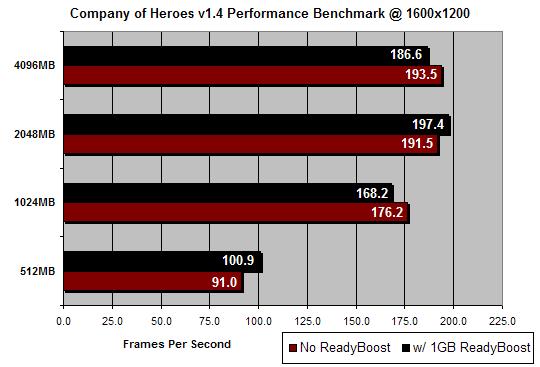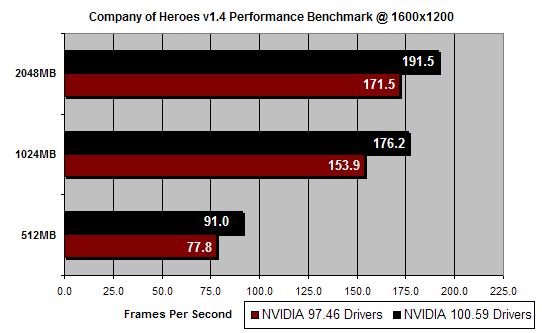Windows ReadyBoost Put To The Test For Gaming
Performance Results
A number of sites have already shown that ReadyBoost helps out systems with just 512MB of DDR2 running in single channel, but what about those that have 1GB, 2GB or 4GB running in dual channel? I just recently picked up a copy of a real-time strategy (RTS) game set in World War II called Company of Heroes and thought I’d give ReadyBoost a shot. The test system was an Intel 975XBX motherboard, Intel Core 2 Duo E6700, Corsair XMS2 PC2-8500 memory and an XFX GeForce 7900GTX graphics card. The most recent patch was applied to the game and NVIDIA 100.59 beta drivers were used for the 7900GTX. The memory was run at 800MHz with 4-4-4-12 2T timings.
The benchmark results were unexpected and random, but each bar on the chart represents the average score of four benchmark runs, so 32 benchmarks were completed to get this chart. Our Kingston DataTraveler ReadyFlash USB 2.0 Flash drive did seem to make a difference with the system running a single 512MB module, but in dual channel (the 1GB, 2GB & 4GB results) mode the results were all over the place. An example of all over the place are the test results for 1GB test group with no ReadyBoost looked like this: 159.1, 163.9, 189.6, 192.1.
Unhappy with the test results I tried to eliminate the cause of the inconsistencies and thinking that it was the game Company of Heroes, tried it on Windows XP Pro with the same results. It would then seem that either the beta NVIDIA graphics driver or Vista Ultimate 32-bit itself is causing the benchmark inconsistencies. I then tested the Windows Vista 32-bit RTM drivers from NVIDIA to see if they could produce more consistent results than the ForceWare Release 100 drivers.
The performance numbers were still all over the place, but if you took the averages of them they did graph out pretty good. It’s clear that the Forceware Release 100 drivers from NVIDIA are better than the Vista 32-bit RTM 97.46 drivers. While we couldn’t rule out the drivers as being the cause of the inconsistencies at least we were able to make use of our time and show that the beta drivers increase performance across the board by greater than 10%!!!
Final Thoughts:
As with so many things in life, we set off in search of something only to find a road block that would keep us from easily finding the answers to what we are looking for. Windows ReadyBoost did seem to improve system performance on the machine with 512MB of memory running in single channel, but when used in our test system with greater than 1GB of memory running dual channel a faster ‘feel’ was not found.
Another observation is that no two brands/models of USB Flash drives will give the same performance results as I tried various Windows ReadyBoost Flash drives with some showing faster benchmark results than others. This could be due to the fact that some Flash drives are faster than others and one will see better performance from the faster devices. Remember that the minimum performance requirement for ReadyBoost is 2.5MB/sec throughput for 4K random reads & 1.75MB/sec throughput for 512K random writes. Since that is not the limit at what Windows Vista can read and write data to the Flash drive not all ReadyBoost Flash drives will have the same level of performance.
On that note a 4K random read from a ReadyBoost Flash drive would be about 10x faster than a typical hard drive. Since our test system has a pair of 10,000RPM Western Digial Raptors running RAID0 the system doesn’t have long periods of heavy disk activity, which is where the end user would see the biggest benefit from ReadyBoost. ReadyBoost is something that all enthusiasts should look into as every system is going to perform differently. With the prices on Flash memory being so low it shouldn’t hurt the budget too much as one could pick up the 1GB Kingston DataTraveler ReadyFlash for ~$22 and for those looking for a higher capacity Kingston also offers a 2GB version for $42 that will be out here shortly.
For now I see ReadyBoost really helping those that don’t know how to add RAM to their system and don’t want to lug machines in to a store front to pay someone to do it. Now all someone has to do is visit a local electronics store and spend right around $20 on a 1gb USB flash drive and bang – much faster 512MB PC in seconds.



Comments are closed.